Immobilization of Catalase on Chitosan/ZnO and Chitosan/ZnO/Fe2O3 Nanocomposites: A Comparative Study
Abstract
:1. Introduction
2. Results and Discussion
2.1. Immobilization of Catalase Enzyme
2.2. ATR–FTIR
2.3. SEM–EDX
2.4. Reusability and Storage Stability
2.5. Biochemical and Physicochemical Characterization
3. Materials and Methods
3.1. Synthesis of ZnO/Chitosan and ZnO/Fe2O3 Chitosan Nanocomposites as an Enzyme Support
3.2. Immobilization Procedure
3.3. Catalase Assay
3.4. Characterization
3.5. Reusability and Storage Stability of the Immobilized Catalase
3.6. Biochemical and Physicochemical Characterization of the Free and Immobilized Catalase
3.6.1. The Effect of pH and Temperature
3.6.2. Thermal Stability and Half-Life of Free and Immobilized Enzyme
3.6.3. Kinetic Constant
4. Conclusions
Supplementary Materials
Author Contributions
Funding
Data Availability Statement
Acknowledgments
Conflicts of Interest
References
- Gan, J.; Bagheri, A.R.; Aramesh, N.; Gul, I.; Franco, M.; Almulaiky, Y.Q.; Bilal, M. Covalent organic frameworks as emerging host platforms for enzyme immobilization and robust biocatalysis–A review. Int. J. Biol. Macromol. 2020, 167, 502–515. [Google Scholar]
- Ma, Y.; Ling, L.; Guo, Y.; Fu, Y.; Shao, Q.; Wu, T.; Guo, S.; Sun, K.; Guo, X.; Wujcik, E.K. Porous lignin based poly(acrylic acid)/organo-montmorillonite nanocomposites: Swelling behaviors and rapid removal of Pb(II) ions. Polymer 2017, 128, 12–23. [Google Scholar] [CrossRef]
- Wu, Z.; Gao, S.; Chen, L.; Jiang, D.; Shao, Q.; Zhang, B.; Zhai, Z.; Wang, C.; Zhao, M.; Ma, Y. Electrically insulated epoxy nanocomposites reinforced with synergistic core–shell SiO2@MWCNTs and montmorillonite bifillers. Macromol. Chem. Phys. 2017, 218, 1700357. [Google Scholar] [CrossRef]
- Wang, C.; Zhao, M.; Li, J.; Yu, J.; Sun, S.; Ge, S.; Guo, X.; Xie, F.; Jiang, B.; Wujcik, E.K. Silver nanoparticles/graphene oxide decorated carbon fiber synergistic reinforcement in epoxy-based composites. Polymer 2017, 131, 263–271. [Google Scholar] [CrossRef]
- Zhang, Y.; Zhao, M.; Zhang, J.; Shao, Q.; Li, J.; Li, H.; Lin, B.; Yu, M.; Chen, S.; Guo, Z. Excellent corrosion protection performance of epoxy composite coatings filled with silane functionalized silicon nitride. J. Polym. Res. 2018, 25, 130. [Google Scholar] [CrossRef]
- Casal, E.; Corzo, N.; Moreno, F.J.; Olano, A. Selective recovery of glycosylated caseinmacropeptide with chitosan. J. Agric. Food Chem. 2005, 53, 1201–1204. [Google Scholar] [CrossRef]
- Bilal, M.; Asgher, M.; Iqbal, M.; Hu, H.; Zhang, X. Chitosan beads immobilized manganese peroxidase catalytic potential for detoxification and decolorization of textile effluent. Int. J. Biol. Macromol. 2016, 89, 181–189. [Google Scholar] [CrossRef]
- Çetinus, Ş.A.; Öztop, H.N. Immobilization of catalase into chemically crosslinked chitosan beads. Enz. Microb. Technol. 2003, 32, 889–894. [Google Scholar] [CrossRef]
- Mohamed, S.A.; Al-Malki, A.L.; Kumosani, T.A.; El-Shishtawy, R.M. Horseradish peroxidase and chitosan: Activation, immobilization and comparative results. Int. J. Biol. Macromol. 2013, 60, 295–300. [Google Scholar] [CrossRef]
- Ifuku, S.; Ikuta, A.; Egusa, M.; Kaminaka, H.; Izawa, H.; Morimoto, M.; Saimoto, H. Preparation of high-strength transparent chitosan film reinforced with surfacedeacetylated chitin nanofibers. Carbohydr. Polym. 2013, 98, 1198–1202. [Google Scholar] [CrossRef]
- Gu, H.; Xu, X.; Zhang, H.; Liang, C.; Lou, H.; Ma, C.; Li, Y.; Guo, Z.; Gu, J. Chitosan-coatedmagnetite with covalently grafted polystyrene based carbon nanocomposites for hexavalent chromium adsorption. Eng. Sci. 2018, 1, 46–54. [Google Scholar] [CrossRef]
- He, Y.; Yang, S.; Liu, H.; Shao, Q.; Chen, Q.; Lu, C.; Jiang, Y.; Liu, C.; Guo, Z. Reinforced carbon fiber laminates with oriented carbon nanotube epoxy nanocomposites: Magnetic field assisted alignment and cryogenic temperaturemechanical properties. J. Colloid Interface Sci. 2018, 517, 40–51. [Google Scholar] [CrossRef]
- Wang, R.H.; Xin, J.H.; Tao, X.M. UV-blocking property of dumbbell-shaped ZnO crystallites on cotton fabrics. Inorg. Chem. 2005, 44, 3926–3930. [Google Scholar] [CrossRef]
- Selvarajan, E.; Mohanasrinivasan, V.; Subathra, C.; George, P. Immobilization of β-galactosidase from Lactobacillus plantarum HF571129 on ZnO nanoparticles: Characterization and lactose hydrolysis. Bioprocess. Biosyst. Eng. 2015, 38, 1655–1669. [Google Scholar] [CrossRef]
- Al-Naamani, L.; Dobretsov, S.; Dutta, J. Chitosan-zinc oxide nanoparticle composite coating for active food packaging applications. Innov. Food Sci. Emerg. Technol. 2016, 38, 231–237. [Google Scholar] [CrossRef]
- Kim, J.; Grate, J.W.; Wang, P. Nanobiocatalysis and its potential applications. Trends Biotechnol. 2008, 26, 639–646. [Google Scholar] [CrossRef] [PubMed]
- Noreen, S.; Asgher, M.; Hussain, F.; Iqbal, A. Performance improvement of Ca-alginate bead cross-linked laccase from Trametes versicolor IBL-04. BioResources 2016, 11, 558–572. [Google Scholar] [CrossRef] [Green Version]
- Mohamed, S.A.; Al-Harbi, M.H.; Almulaiky, Y.Q.; Ibrahim, I.H.; El-Shishtawy, R.M. Immobilization of horseradish peroxidase on Fe3O4 magnetic nanoparticles. Electron. J. Biotechnol. 2017, 27, 84–90. [Google Scholar] [CrossRef]
- Lin, J.; Fan, L.; Miao, R.; Le, X.; Chen, S.; Zhou, X. Enhancing catalytic performance of laccase via immobilization on chitosan/CeO2 microspheres. Int. J. Biol. Macromol. 2015, 78, 1–8. [Google Scholar] [CrossRef]
- Aldhahri, M.; Almulaiky, Y.Q.; El-Shishtawy, R.M.; Al-Shawafi, W.M.; Salah, N.; Alshahrie, A.; Alzahrani, H.A. Ultra-thin 2D CuO nanosheet for HRP immobilization supported by encapsulation in a polymer matrix: Characterization and dye degradation. Catal. Lett. 2021, 151, 232–246. [Google Scholar] [CrossRef]
- Almulaiky, Y.Q.; Al-Harbi, S.A. A novel peroxidase from Arabian balsam (Commiphora gileadensis) stems: Its purification, characterization and immobilization on a carboxymethylcellulose/Fe3O4 magnetic hybrid material. Int. J. Biol. Macromol. 2019, 133, 767–774. [Google Scholar] [CrossRef]
- Çetinus, Ş.A.; Şahin, E.; Saraydin, D. Preparation of Cu (II) adsorbed chitosan beads for catalase immobilization. Food Chem. 2009, 114, 962–969. [Google Scholar] [CrossRef]
- Czechowska, E.; Ranoszek-Soliwoda, K.; Tomaszewska, E.; Pudlarz, A.; Celichowski, G.; Gralak-Zwolenik, D.; Grobelny, J. Comparison of the antioxidant activity of catalase immobilized on gold nanoparticles via specific and non-specific adsorption. Colloids Surf. B Biointerface 2018, 171, 707–714. [Google Scholar] [CrossRef]
- Ghaffari, S.B.; Sarrafzadeh, M.H.; Salami, M.; Khorramizadeh, M.R. A pH-sensitive delivery system based on N-succinyl chitosan-ZnO nanoparticles for improving antibacterial and anticancer activities of curcumin. Int. J. Biol. Macromol. 2020, 151, 428–440. [Google Scholar] [CrossRef] [PubMed]
- Pinheiro, B.B.; Rios, N.S.; Aguado, E.R.; Fernandez-Lafuente, R.; Freire, T.M.; Fechine, P.B.; Gonçalves, L.R. Chitosan activated with divinyl sulfone: A new heterofunctional support for enzyme immobilization. Application in the immobilization of lipase B from Candida antarctica. Int. J. Biol. Macromol. 2019, 130, 798–809. [Google Scholar] [CrossRef] [PubMed]
- El-Shishtawy, R.M.; Mohamed, S.A.; Asiri, A.M.; Ahmed, N.S.E. Synthesis of hemicyanine-based chitosan ligands in dye-affinity chromatography for the purification of chewing stick peroxidase. Int. J. Biol. Macromol. 2020, 148, 401–414. [Google Scholar] [CrossRef] [PubMed]
- Yadav, M.; Singh, V.; Sharma, Y.C. Methyl transesterification of waste cooking oil using a laboratory synthesized reusable heterogeneous base catalyst: Process optimization and homogeneity study of catalyst. Energy Convers. Manag. 2017, 148, 1438–1452. [Google Scholar] [CrossRef]
- Hong, R.Y.; Li, J.H.; Chen, L.L.; Liu, D.Q.; Li, H.Z.; Zheng, Y.; Ding, J.J. Synthesis, surface modification and photocatalytic property of ZnO nanoparticles. Powder Technol. 2009, 189, 426–432. [Google Scholar] [CrossRef]
- Hwang, S.W.; Umar, A.; Dar, G.N.; Kim, S.H.; Badran, R.I. Synthesis and Characterization of Iron Oxide Nanoparticles for Phenyl Hydrazine Sensor Applications. Sens. Lett. 2014, 12, 97–101. [Google Scholar] [CrossRef]
- Almulaiky, Y.Q.; Aqlan, F.M.; Aldhahri, M.; Baeshen, M.; Khan, T.J.; Khan, K.A.; Alayafi, A.A. α-Amylase immobilization on amidoximated acrylic microfibres activated by cyanuric chloride. R. Soc. Open Sci. 2018, 5, 172164. [Google Scholar] [CrossRef] [PubMed] [Green Version]
- Defaei, M.; Taheri-Kafrani, A.; Miroliaei, M.; Yaghmaei, P. Improvement of stability and reusability of α-amylase immobilized on naringin functionalized magnetic nanoparticles: A robust nanobiocatalyst. Int. J. Biol. Macromol. 2018, 113, 354–360. [Google Scholar] [CrossRef] [PubMed]
- Al-Najada, A.R.; Almulaiky, Y.Q.; Aldhahri, M.; El-Shishtawy, R.M.; Mohamed, S.A.; Baeshen, M.; Al-Harbi, S.A. Immobilisation of α-amylase on activated amidrazone acrylic fabric: A new approach for the enhancement of enzyme stability and reusability. Sci. Rep. 2019, 9, 1–9. [Google Scholar] [CrossRef] [Green Version]
- Alptekin, Ö.; Tükel, S.S.; Yıldırım, D.; Alagöz, D. Immobilization of catalase onto Eupergit C and its characterization. J. Mol. Catal. B Enzym. 2010, 64, 177–183. [Google Scholar] [CrossRef]
- Kaushal, J.; Singh, G.; Arya, S.K. Immobilization of catalase onto chitosan and chitosan–bentonite complex: A comparative study. Biotechnol. Rep. 2018, 18, e00258. [Google Scholar] [CrossRef] [PubMed]
- Abdulaal, W.H.; Almulaiky, Y.Q.; El-Shishtawy, R.M. Encapsulation of HRP enzyme onto a magnetic Fe3O4 Np–PMMA film via casting with sustainable biocatalytic activity. Catalysts 2020, 10, 181. [Google Scholar] [CrossRef] [Green Version]
- Almulaiky, Y.Q.; El-Shishtawy, R.M.; Aldhahri, M.; Mohamed, S.A.; Afifi, M.; Abdulaal, W.H.; Mahyoub, J.A. Amidrazone modified acrylic fabric activated with cyanuric chloride: A novel and efficient support for horseradish peroxidase immobilization and phenol removal. Int. J. Biol. Macromol. 2019, 140, 949–958. [Google Scholar] [CrossRef]
- Mazlan, S.Z.; Hanifah, S.A. Effects of temperature and pH on immobilized laccase activity in conjugated methacrylate-acrylate microspheres. Int. J. Polym. Sci. 2017, 2017, 1–8. [Google Scholar] [CrossRef] [Green Version]
- Zeyadi, M.; Almulaiky, Y.Q. A novel peroxidase from Ziziphus jujuba fruit: Purification, thermodynamics and biochemical characterization properties. Sci. Rep. 2020, 10, 1–11. [Google Scholar] [CrossRef]
- Lamb, S.B.; Stuckey, D.C. Enzyme immobilization on colloidal liquid aphrons (CLAs): The influence of system parameters on activity. Enzym. Microb. Technol. 2000, 26, 574–581. [Google Scholar] [CrossRef]
- Bibi, Z.; Shahid, F.; Ali, S.; Qader, U.; Aman, A. Agar-agar entrapment increases the stability of endo-β-1, 4-xylanase for repeated biodegradation of xylan. Int. J. Biol. Macromol. 2015, 75, 121–127. [Google Scholar] [CrossRef]
- Esawy, M.A.; Combet-Blanc, Y. Immobilization of Bacillus licheniformis 5A1 milk-clotting enzyme and characterization of its enzyme properties. World J. Microbiol. Biotechnol. 2006, 22, 197–200. [Google Scholar] [CrossRef]
- Aebi, H. Catalase. In Methods of Enzymatic Analysis, 2nd ed.; Bergmayer, H., Ed.; Verlag Chemie International: Deerfield Beach, FL, USA, 1981; pp. 673–684. [Google Scholar]
- Gohel, S.D.; Singh, S.P. Characteristics and thermodynamics of a thermostable protease from a salt-tolerant alkaliphilic actinomycete. Int. J. Biol. Macromol. 2013, 56, 20–27. [Google Scholar] [CrossRef] [PubMed]
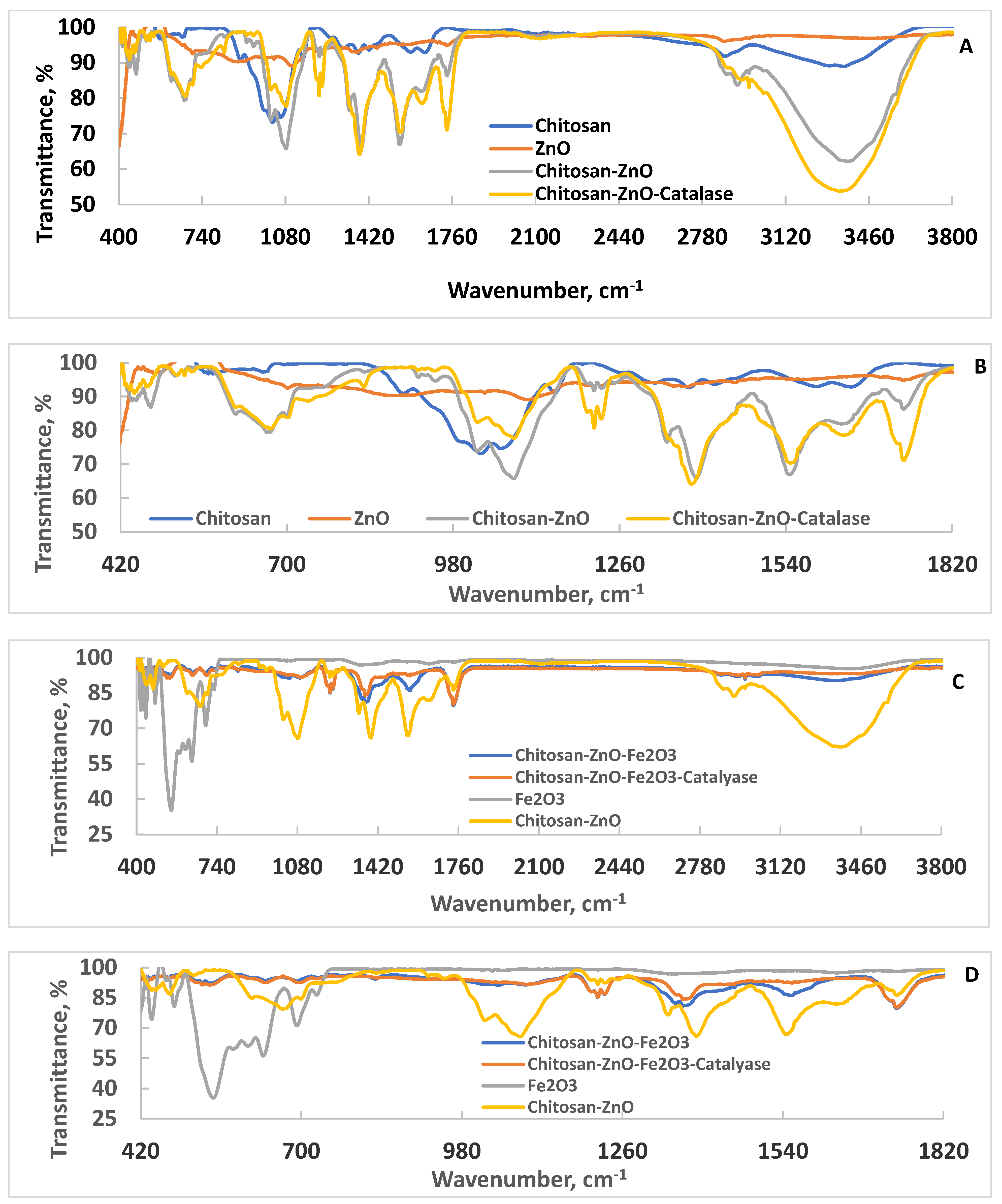
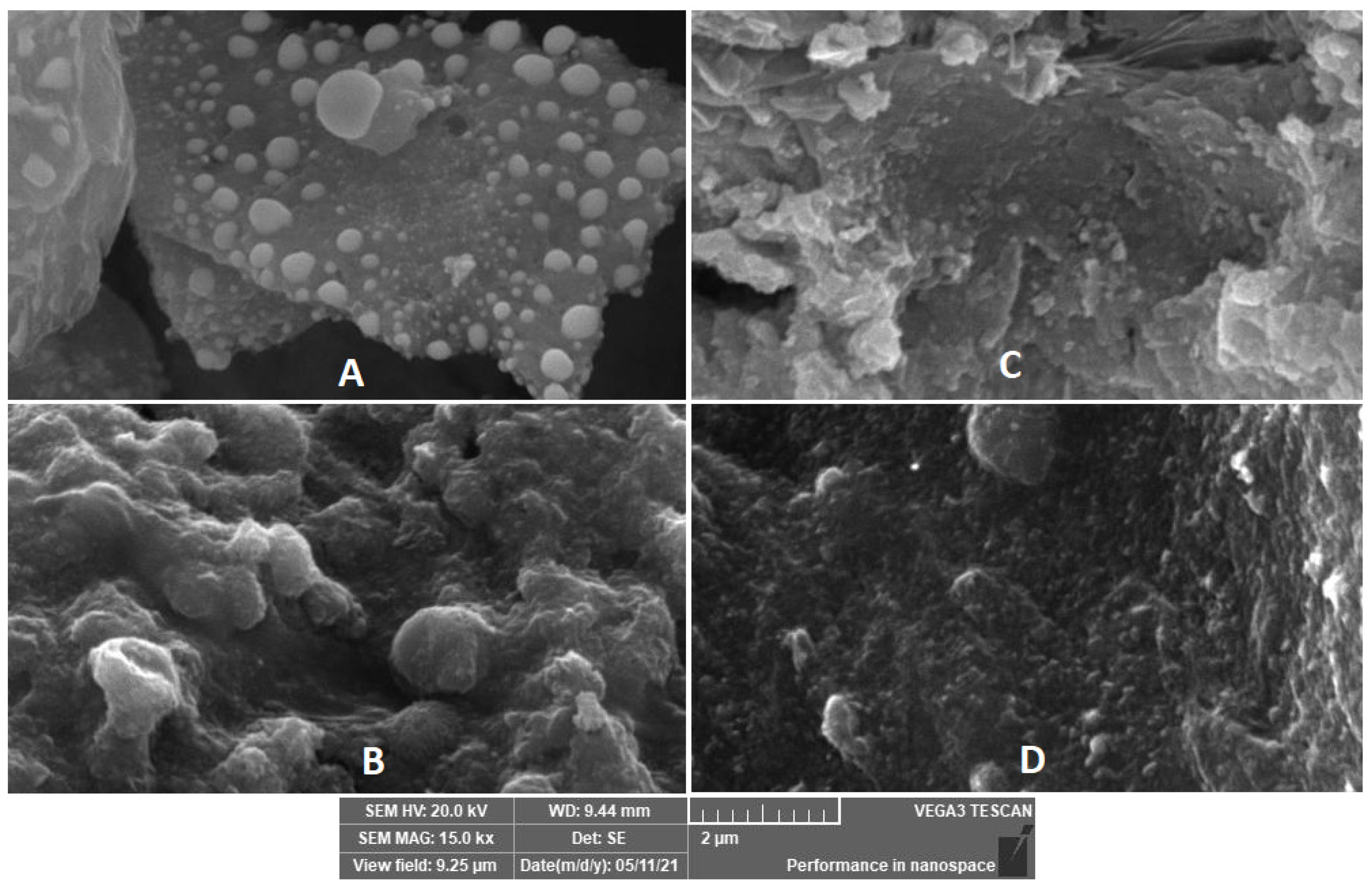
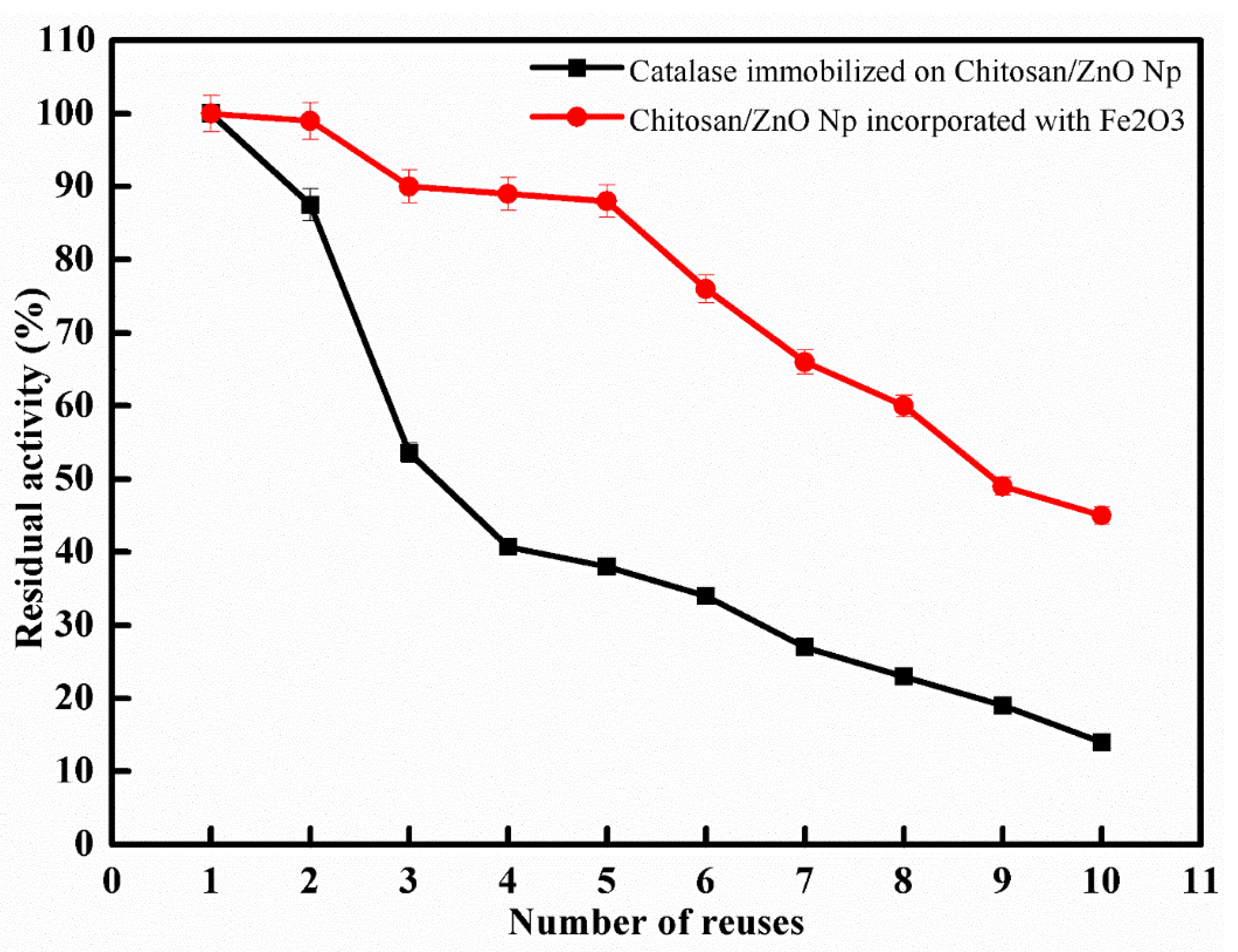
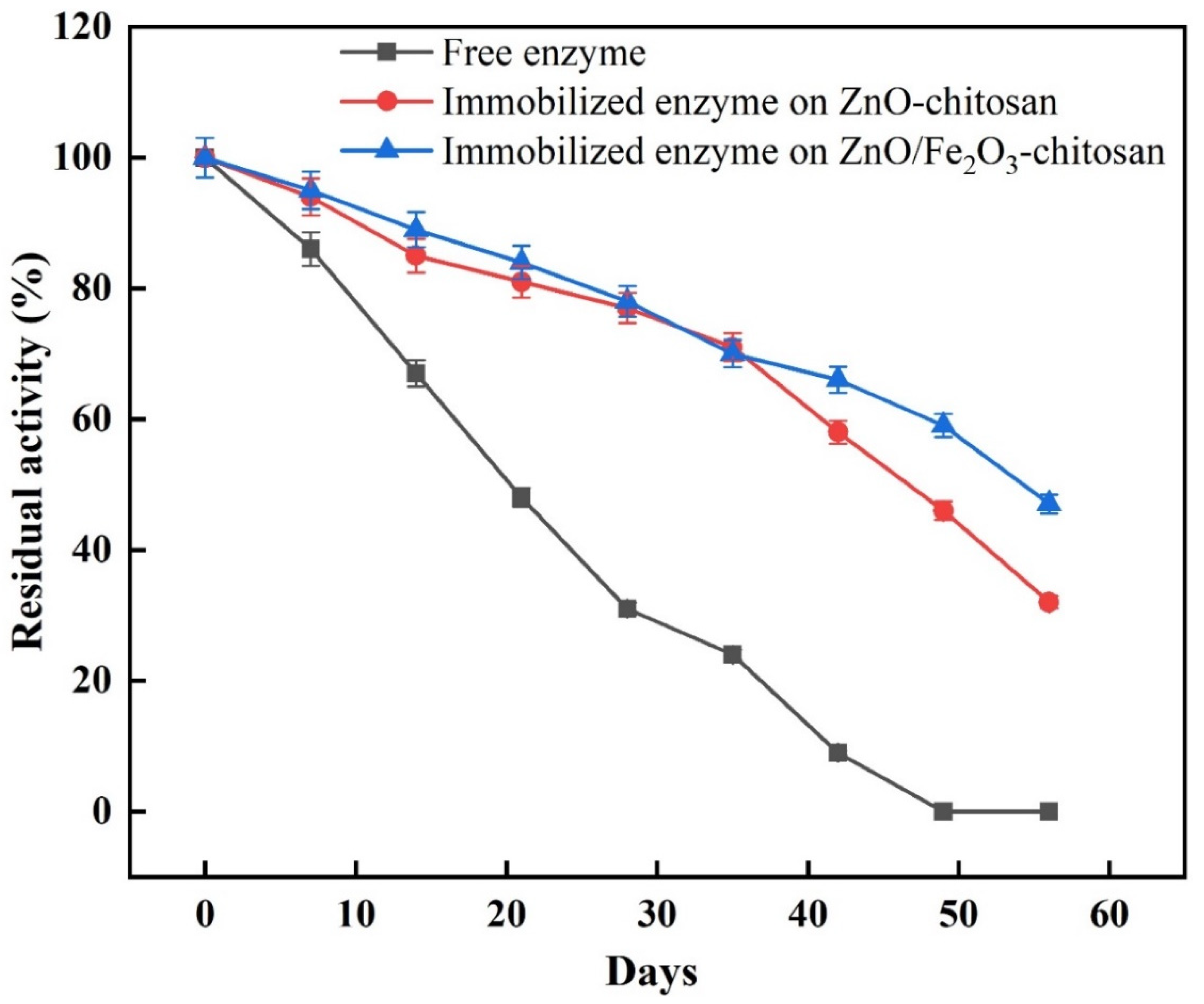
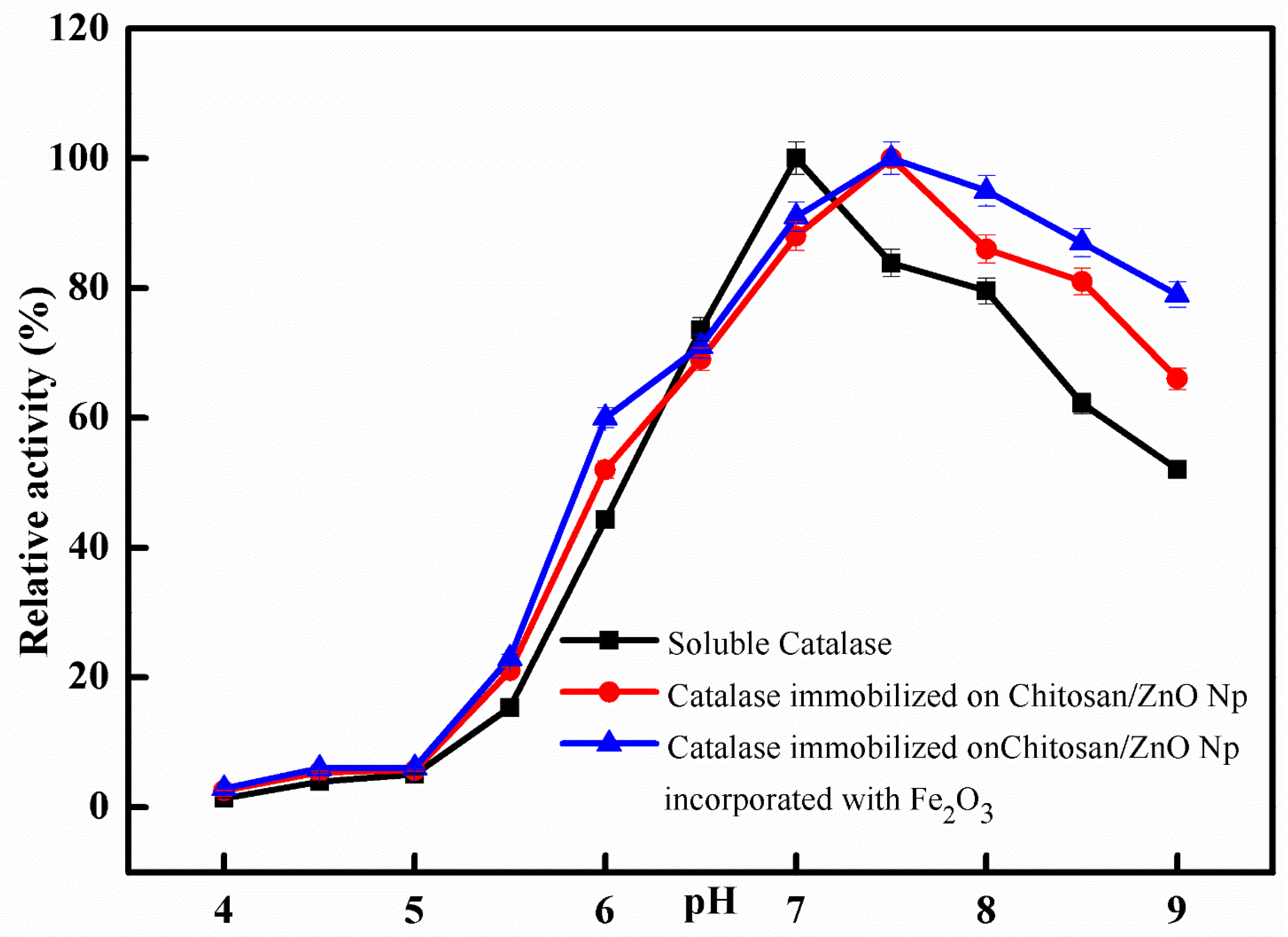
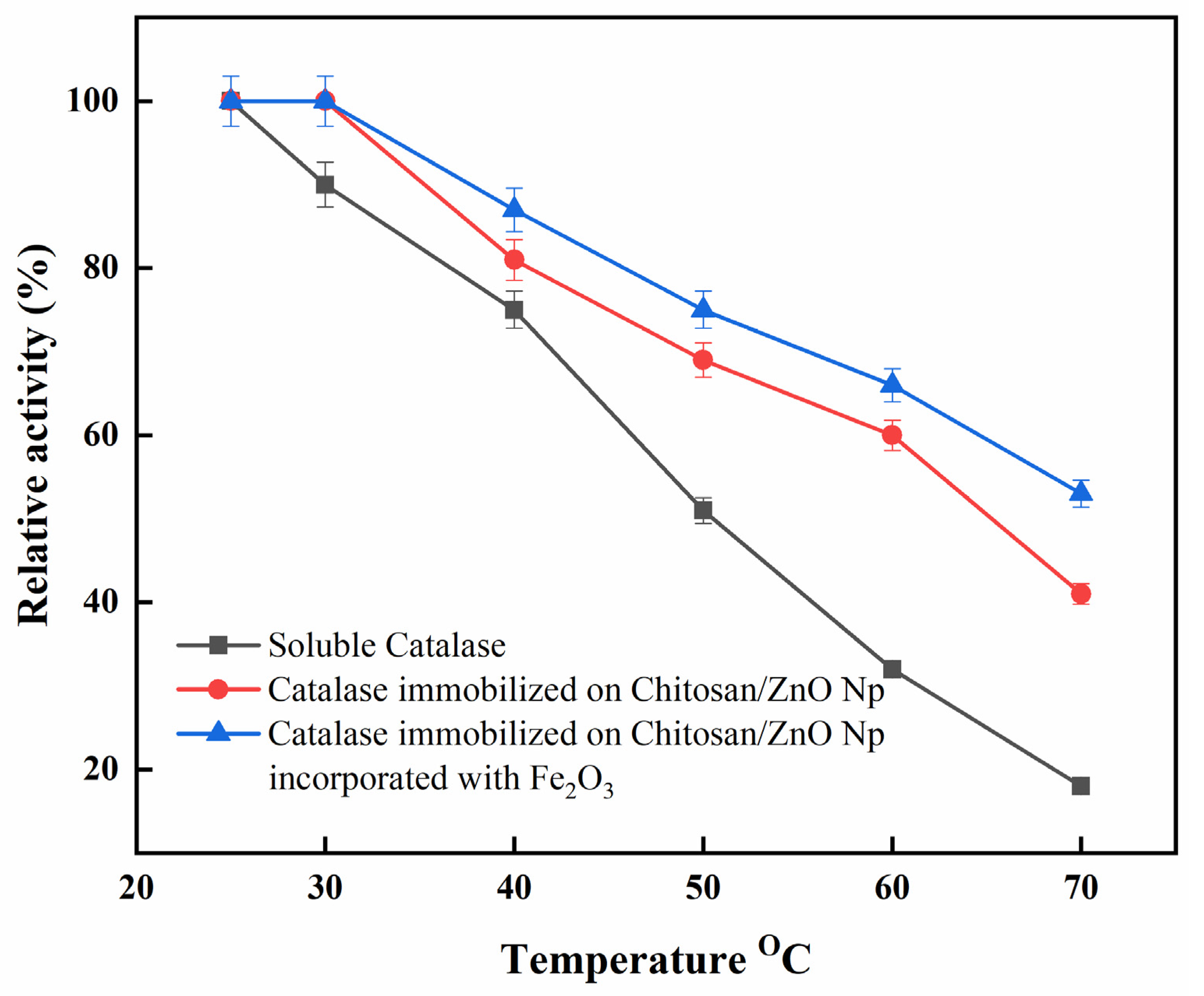
| Concentration ZnO Np | Concentration Fe2O3 Np | Ionic Strength | Immobilization Yield (%) | Catalase Activity u/g Support | S.A U/mg Protein |
|---|---|---|---|---|---|
| 0.2 g (10 %) | - | pH 8 | 21 | 123 | 309 |
| 0.4 g (20%) | - | 37 | 183.5 | 417 | |
| 0.6 g (30%) | - | 25 | 154 | 364 | |
| - | 0.1 g (5%) | pH 8 | 24.9 | 188 | 272 |
| 0.2 g (10%) | 84.32 | 500 | 885 | ||
| 0.3 g (15%) | 38 | 234 | 362 |
| Km (mM) | Vmax (µmole/mL) | |
|---|---|---|
| Immobilized Enzyme on CS/ZnO | 225.17 | 15.87 |
| Immobilized Enzyme on CS/ZnO/ Fe2O3 | 221.59 | 19.92 |
| Free Enzyme | 91.28 | 10.45 |
| Temperature (°C) | Free Enzyme | Immobilized Enzyme on CS/ZnO | Immobilized Enzyme on CS/ZnO/Fe2O3 | ||||||
|---|---|---|---|---|---|---|---|---|---|
| Kd | t1/2 (min) | Ea kJ/mole | Kd | t1/2 (min) | Ea kJ/mole | Kd | t1/2 (min) | Ea kJ/mole | |
| 30 | 0.004 | 173 | 36.82 | 0.002 | 347 | 15.94 | 0.001 | 693 | 12.41 |
| 40 | 0.006 | 116 | 0.003 | 231 | 0.002 | 345 | |||
| 50 | 0.014 | 50 | 0.009 | 77 | 0.003 | 231 | |||
| 60 | 0.028 | 27 | 0.013 | 46 | 0.004 | 173 | |||
| 70 | 0.029 | 24 | 0.028 | 25 | 0.022 | 32 | |||
Publisher’s Note: MDPI stays neutral with regard to jurisdictional claims in published maps and institutional affiliations. |
© 2021 by the authors. Licensee MDPI, Basel, Switzerland. This article is an open access article distributed under the terms and conditions of the Creative Commons Attribution (CC BY) license (https://creativecommons.org/licenses/by/4.0/).
Share and Cite
El-Shishtawy, R.M.; Ahmed, N.S.E.; Almulaiky, Y.Q. Immobilization of Catalase on Chitosan/ZnO and Chitosan/ZnO/Fe2O3 Nanocomposites: A Comparative Study. Catalysts 2021, 11, 820. https://doi.org/10.3390/catal11070820
El-Shishtawy RM, Ahmed NSE, Almulaiky YQ. Immobilization of Catalase on Chitosan/ZnO and Chitosan/ZnO/Fe2O3 Nanocomposites: A Comparative Study. Catalysts. 2021; 11(7):820. https://doi.org/10.3390/catal11070820
Chicago/Turabian StyleEl-Shishtawy, Reda M., Nahed S. E. Ahmed, and Yaaser Q. Almulaiky. 2021. "Immobilization of Catalase on Chitosan/ZnO and Chitosan/ZnO/Fe2O3 Nanocomposites: A Comparative Study" Catalysts 11, no. 7: 820. https://doi.org/10.3390/catal11070820






